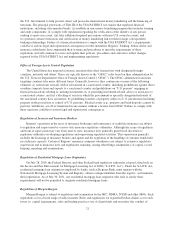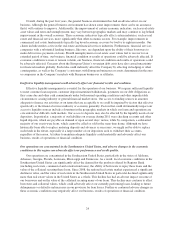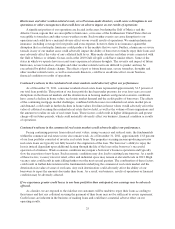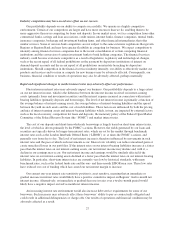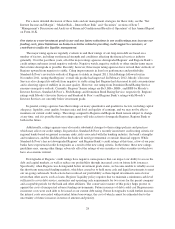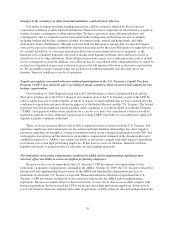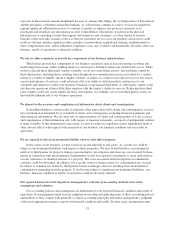Regions Bank 2011 Annual Report Download - page 48
Download and view the complete annual report
Please find page 48 of the 2011 Regions Bank annual report below. You can navigate through the pages in the report by either clicking on the pages listed below, or by using the keyword search tool below to find specific information within the annual report.Overall, during the past four years, the general business environment has had an adverse effect on our
business. Although the general business environment has shown some improvement, there can be no assurance
that it will continue to improve. Additionally, the improvement of certain economic indicators, such as real estate
asset values and rents and unemployment, may vary between geographic markets and may continue to lag behind
improvement in the overall economy. These economic indicators typically affect certain industries, such as real
estate and financial services, more significantly than other economic sectors. For example, improvements in
commercial real estate fundamentals typically lag broad economic recovery by twelve to eighteen months. Our
clients include entities active in the real estate and financial services industries. Furthermore, financial services
companies with a substantial lending business, like ours, are dependent upon the ability of their borrowers to
make debt service payments on loans. Should unemployment or real estate asset values fail to recover for an
extended period of time, our business, financial condition or results of operations could be adversely affected. If
economic conditions worsen or remain volatile, our business, financial condition and results of operations could
be adversely affected. Concerns about the European Union’s sovereign debt crisis have also caused uncertainty
for financial markets globally. Such risks could indirectly affect the Company by affecting its hedging or other
counterparties, as well as the Company’s customers with European businesses or assets denominated in the euro
or companies in the Company’s markets with European businesses or affiliates.
Ineffective liquidity management could adversely affect our financial results and condition.
Effective liquidity management is essential for the operation of our business. We require sufficient liquidity
to meet customer loan requests, customer deposit maturities/withdrawals, payments on our debt obligations as
they come due and other cash commitments under both normal operating conditions and other unpredictable
circumstances causing industry or general financial market stress. Our access to funding sources in amounts
adequate to finance our activities or on terms that are acceptable to us could be impaired by factors that affect us
specifically or the financial services industry or economy generally. Factors that could detrimentally impact our
access to liquidity sources include a downturn in the geographic markets in which our loans and operations are
concentrated or difficult credit markets. Our access to deposits may also be affected by the liquidity needs of our
depositors. In particular, a majority of our liabilities on average during 2011 were checking accounts and other
liquid deposits, which are payable on demand or upon several days’ notice, while by comparison, a substantial
majority of our assets were loans, which cannot be called or sold in the same time frame. Although we have
historically been able to replace maturing deposits and advances as necessary, we might not be able to replace
such funds in the future, especially if a large number of our depositors seek to withdraw their accounts,
regardless of the reason. A failure to maintain adequate liquidity could materially and adversely affect our
business, results of operations or financial condition.
Our operations are concentrated in the Southeastern United States, and adverse changes in the economic
conditions in this region can adversely affect our performance and credit quality.
Our operations are concentrated in the Southeastern United States, particularly in the states of Alabama,
Arkansas, Georgia, Florida, Louisiana, Mississippi and Tennessee. As a result, local economic conditions in the
Southeastern United States can significantly affect the demand for the products offered by Regions Bank
(including real estate, commercial and construction loans), the ability of borrowers to repay these loans and the
value of the collateral securing these loans. Since 2008, the national real estate market experienced a significant
decline in value, and the value of real estate in the Southeastern United States in particular declined significantly
more than real estate values in the United States as a whole. This decline has had an adverse impact on some of
our borrowers and on the value of the collateral securing many of our loans. This decline may continue to affect
borrowers and collateral values, which could adversely affect our currently performing loans, leading to future
delinquencies or defaults and increases in our provision for loan losses. Further or continued adverse changes in
these economic conditions may negatively affect our business, results of operations or financial condition.
24









